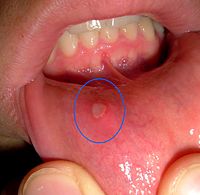
Photo from wikipedia
Background Pleomorphic adenoma (PA) is the most frequent benign salivary gland tumor, but a lip PA is rare. Although this tumor may be definitively diagnosed by imaging or a tissue… Click to show full abstract
Background Pleomorphic adenoma (PA) is the most frequent benign salivary gland tumor, but a lip PA is rare. Although this tumor may be definitively diagnosed by imaging or a tissue biopsy if it is reasonably large, PAs on the lip are relatively small, and they present findings that are similar to those of other lip lesions, which can make a preoperative diagnosis difficult. Methods We analyzed all PAs in the oral region and lesions on the lips treated in our department over the past 20 years, and we discuss them together with the relevant literature. Results We found that 11.8% (n=6) of the PAs occurred on a lip (upper lip: 9.8%, lower lip: 2.0%), and ~1% of all mass lesions of the lips were PAs. The average size of the lip PAs was 1.5±0.7 cm (range, 0.7–2.2 cm). For preoperative diagnostic assistance, ultrasonography (US) (n=4), magnetic resonance (MR) (n=3), or no imaging (n=2) was used. An excisional biopsy was performed in all cases, and to date, no recurrence or malignant transformation has been observed. Conclusions Lip PA is relatively rare. Because almost all of these lesions are small, a preoperative diagnosis is more difficult compared to palatal lesions. This tumor is also prone to long-term neglect and has the potential for recurrence and malignant transformation. It is thus necessary to perform an excision that includes the capsule and surrounding tissues, and careful postoperative follow-up should be continued.
Journal Title: Gland Surgery
Year Published: 2022
Link to full text (if available)
Share on Social Media: Sign Up to like & get
recommendations!